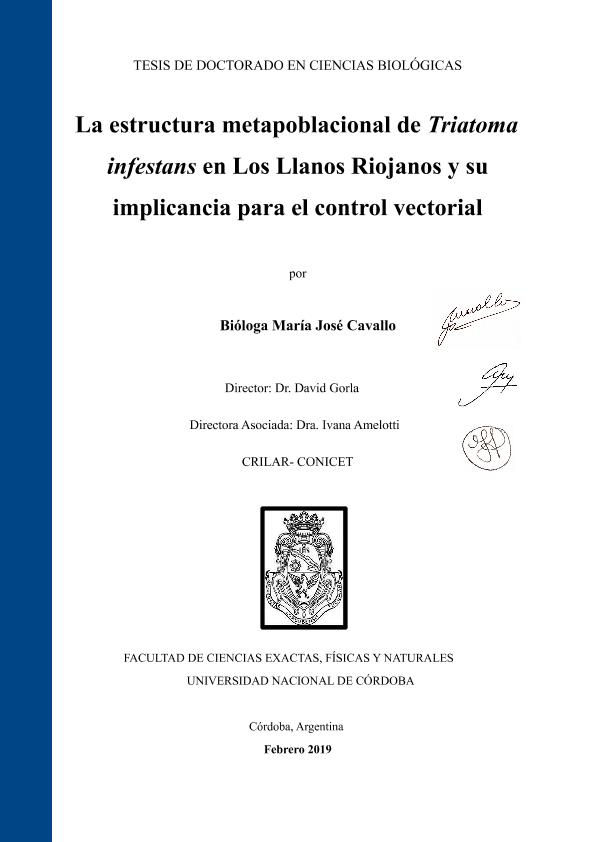Tesis doctoral
Triatoma infestans (Hemiptera: Reduviidae) es un insecto hematófago, vector del parásito Trypanosoma cruzi, agente etiológico de la Enfermedad de Chagas, considerada endémica de Argentina. En el sur de La Rioja, la persistente infestación por triatominos, fomentó que a partir del año 2008, se implementara un Programa de Erradicación de Ranchos y construcción de Viviendas Nuevas en la zona rural, con el objetivo de disminuir la infestación. Al analizar esta situación desde el contexto de la teoría de metapoblaciones, se considera que cada vivienda se comporta como un parche con distintos grados de calidad, en relación a la disponibilidad de refugios para T. infestans. De esta forma, las Viviendas Nuevas son consideradas de menor calidad comparadas con las Viviendas Rancho-Tradicionales. Los principales objetivos del presente trabajo fueron actualizar el estado de infestación en los Llanos riojanos, identificar los factores de riesgo asociados a la misma y evaluar la infestación en parches de diferente calidad y tamaño. El estudio se realizó analizando 397 viviendas con distintas Tipologías pertenecientes a los Departamentos Ángel Vicente Peñaloza, Rosario Vera Peñaloza y San Martín (Los Llanos, La Rioja) durante el período 2014-2017. Se realizaron muestreos pasivos y activos para estimar la infestación por T. infestans en los diferentes parches.Los principales resultados mostraron heterogeneidad espacial respecto a la infestación por T. infestans en el área de estudio, siendo Rosario Vera Peñaloza y San Martín los Departamentos con mayor infestación. El análisis de factores de riesgo a través de un enfoque de inferencia multimodelo, permitió ponderar las variables con mayor impacto en la probabilidad de infestación. Se observó que la Cantidad de Viviendas y su condición entomológica influyen de manera directa en la infestación de la Unidad Domiciliaria. Otras variables, como Cantidad de Estructuras Peridomésticas y Tipología de la Vivienda, no mostraron efecto cuantificable sobre la probabilidad de infestación. Durante el período estudiado, se registraron cambios en el estado de colonización y extinción de los parches entre tiempos consecutivos, permitiendo evaluar la dinámica de infestación en el área. Se constató que parches de diferentes características, incluso los considerados de baja calidad y menor tamaño, se encontraban ocupados por T. infestans. Adicionalmente, se obtuvo un registro detallado de las especies, que junto a T. infestans, invaden los parches en estudio, siendo las más frecuentes T. guasayana y T. garciabesi. La integración de estos resultados, permitió evaluar el impacto de la construcción de Nuevas Viviendas y el control químico aplicado en el área, sobre la prevalencia de infestación por T. infestans, en un contexto metapoblacional. Triatoma infestans (Hemiptera: Reduviidae) is a hematophagous insect, vector of the parasite Trypanosoma cruzi, etiological agent of Chagas disease, considered endemic in Argentina. In the south of La Rioja, as from 2008, the persistent infestation by triatomines, encouraged, a “Progama de Erradicación de Ranchos” and the construction of new housing in the rural area with the aim of reducing infestation. When analyzing this situation from the metapopulation theory context, it is considered that each dwelling behaves as a patch with different degrees of quality, in relation to the availability of shelters for T. infestans. In this way, the New Houses are considered of lower quality compared to the Traditional Houses. The main objectives of this study were to update the state of infestation in Los Llanos of La Rioja, to identify the risk factors associated with it and to evaluate the infestation in patches of different quality and size. The study was carried out analyzing 397 houses with different Typologies belonging to the Departments Ángel Vicente Peñaloza, Rosario Vera Peñaloza and San Martín (Los Llanos, La Rioja) during the period 2014-2017. Passive and active samplings were taken to estimate the infestation by T. infestans in the different patches. The main results showed spatial heterogeneity with respect to infestation by T. infestans in the study area. Rosario Vera Peñaloza and San Martín were the Departments with the highest infestation. The analysis of risk factors through a multimodal inference approach allowed us to weigh the variables with the greatest impact on the probability of infestation. It was observed that the Number of Houses and their entomological condition directly influence the infestation of the House. Other variables, such as Number of peridomestic Structures and Housing Typology, showed no measurable effect on the probability of infestation. During the period studied, changes were recorded in the colonization and the extinction status of the patches between consecutive times, allowing the evaluation of the infestation dynamics in the area. It was found that patches of different characteristics, even those considered of low quality and smaller size, were occupied by T. infestans. Additionally, a detailed record of the species was obtained, which together with T. infestans, invade the patches under study, being T. guasayana and T. garciabesi the most frequent ones. The integration of these results, allowed us to evaluate the impact of the construction of New Houses and the chemical control applied in the area, on the prevalence of infestation by T. infestans, in a metapopulation context.
La estructura metapoblacional de Triatoma infestans en Los Llanos Riojanos y su implicancia para el control vectorial
Cavallo, María José

Director:
Gorla, David Eladio

Codirector:
Amelotti, Ivana

Fecha de publicación:
25/02/2019
Idioma:
Español
Clasificación temática:
Resumen
Archivos asociados
Licencia
Identificadores
Colecciones
Tesis(CRILAR)
Tesis de CENTRO REGIONAL DE INV. CIENTIFICAS Y TRANSFERENCIA TECNOLOGICA DE ANILLACO
Tesis de CENTRO REGIONAL DE INV. CIENTIFICAS Y TRANSFERENCIA TECNOLOGICA DE ANILLACO
Citación
Cavallo, María José; Gorla, David Eladio; Amelotti, Ivana; La estructura metapoblacional de Triatoma infestans en Los Llanos Riojanos y su implicancia para el control vectorial; 25-2-2019
Compartir



